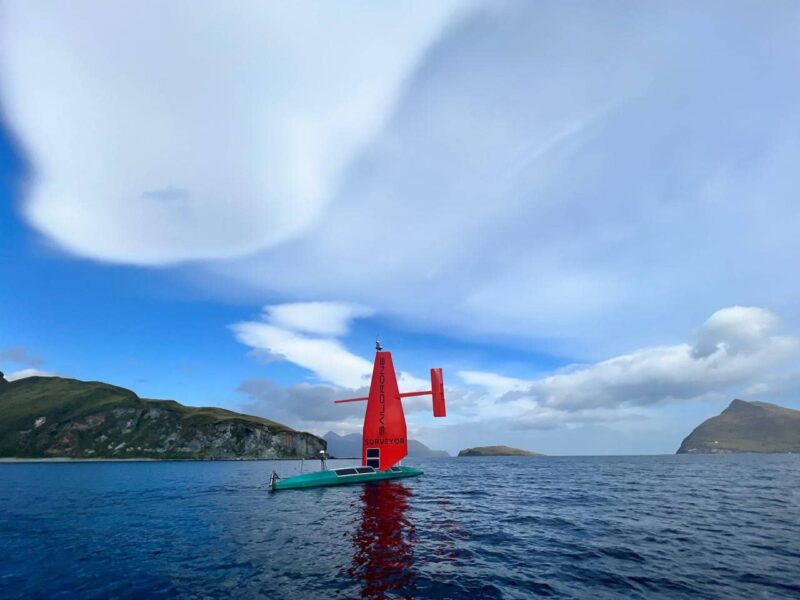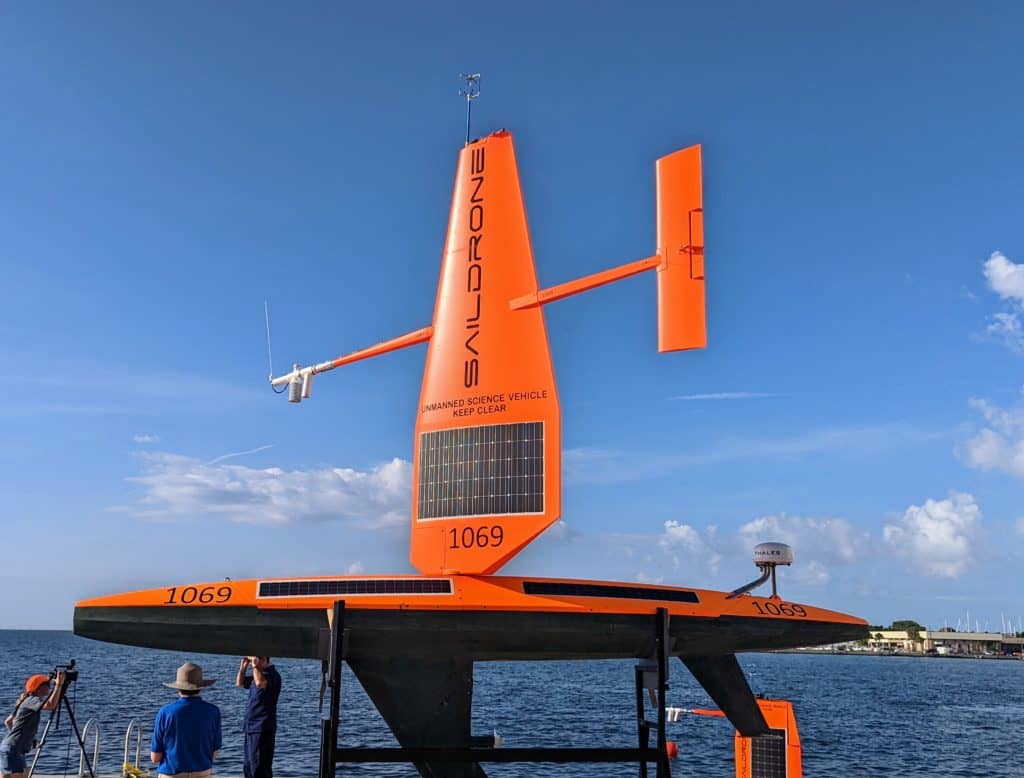Saildrone reaches unmanned maritime milestones

A company operating out of St. Petersburg’s Maritime and Defense Technology Hub recently completed the first uncrewed Alaska ocean mapping mission and discovered a 3,200-foot-tall seamount on its way back to port.
While Saildrone conducts ocean mapping operations from St. Pete’s Innovation District, its Surveyor – the world’s largest unmanned ocean mapping vehicle – set sail from company headquarters in Alameda, California, in June 2022. It recently returned after mapping 4,739 square nautical miles of unknown seafloor around the Aleutian Islands.
The United States Exclusive Economic Zone stretches 200 nautical miles from shore, and the majority remains unmapped, unobserved and unexplored. The Aleutians border Russia and “is by far” the least mapped EEZ region, resulting in scientific, defense and commercial implications.
“If we don’t know what’s there, we can’t protect or manage it,” said Brian Connon, VP of ocean mapping. “And the first step to knowing what’s there is to do that mapping piece.”
Despite accounting for 71% of Earth’s surface, humans have only explored 5% of the world’s oceans. That underscores the need for Saildrone’s St. Petersburg-based efforts and the Alaskan mission.
The months-long exploration of the Aleutians and California coast represents a multi-agency public-private partnership funded by the National Oceanic and Atmospheric Administration (NOAA) and the Bureau of Ocean Energy Management (OEM).
Saildrone’s Surveyor SD 1200 carried an extensive technological array from the Monterey Bay Aquarium Research Institute to sample environmental DNA. The “groundbreaking lab in a can” collected vital information about marine biodiversity and ocean health from genetic “fingerprints” left behind by ocean life.
“The location is so remote,” Connon said. “A lot of people don’t appreciate that about Alaska. One, how huge it is, and two, just how far it stretches out across the Pacific. That’s the real reason there hasn’t been a lot of focus on that part of the ocean.”

A Saildrone field team with the Surveyor while in port.
There is also a threat to human life. Severe weather is the norm rather than the exception around the Aleutians, and the Surveyor collected high-quality data through extreme temperatures, winds and swells reaching over 16 feet.
St. Petersburg’s smaller Saildrones regularly withstand hurricane-force winds and waves – and Connon noted using unmanned vessels instead of a crewed survey ship could mean the difference between life and death.
“You’re not putting all those people in harm’s way,” he added. “People have tolerance levels of how bad the seas can be before they leave, and with some of the conditions we experienced up there, a ship would have not stayed on station.
“You can look at the cost (savings), but it’s hard to put a price on safety. So, if we can avoid sending people out, we should do that.”
He said that as the Aleutian shipping and fishing industry increases, so does NOOA’s focus on the area. Mapping the region bolsters navigational safety, while scientific research supports healthy fisheries.
Stakeholders continue noticing declining stocks of marine life, and Connon said the goal is to ascertain whether that is due to overfishing, changing water temperatures or relocated habitats. Mapping data from previously uncharted waters aids those efforts.
“Every American, in one way or another, depends on the ocean – from protein to from fish to feed animals or humans, to deep-sea cables that make the internet possible,” said Dr. Aurora Elmore, Cooperative Institute manager at NOAA Ocean Exploration, in a statement. “The only way the U.S. can maximize our ocean resources is to understand what’s there.”
Connon added that illegal, unreported and unregulated fishing “is a huge problem.” He called Saildrone’s vessels, which can stay at sea for several months, “persistent eyes and ears” in the ocean for U.S. Navy and Coast Guard.
China’s spy balloon first entered American airspace near the Aleutians, and Saildrone’s onboard cameras and radar extend the U.S. military’s reach.
“When trying to cover so much of the ocean with a ship or aircraft, something is always missed,” Connon said. “That’s something that the Navy, Coast Guard and (U.S.) Border Patrol are all very interested in, and we’re working closely with them right now.”
On its way back to California, the Surveyor SD 1200 discovered a previously unidentified underwater mountain. At 3,200 feet, the seamount stands higher than the world’s tallest building – the Burj Khalifa.
Saildrone researchers didn’t quite stumble upon the massive undersea feature, as Connon said satellites indicated something significant was in that previously unmapped portion of the California coast. However, he relayed that “it was not clear or distinct as what we actually found.”

A Saildrone USV sits outside its ocean mapping headquarters at St. Pete’s Maritime and Defense Technology Hub. Photo by Mark Parker.
A manned OEM research vessel will further explore that marine habitat, and the recently mapped Alaskan seafloor, in future expeditions.
While St. Petersburg’s Saildrones feature a different sonar system, for use in much shallower waters, Connon said those missions share the same concept. High-resolution bathymetry supports Florida’s coastal resilience and helps model storm surge forecasts.
He said state leadership is now devoting more money to those efforts, as most of the eastern Gulf of Mexico remains unexplored according to modern standards.
“There is a lot of space out there that has not been mapped by these sonars,” Connon said. “Yeah, there’s a lot of work to do in Florida.”








Mark A Parker
March 25, 2023at4:16 pm
Thanks Peter. What a time for a STEAM “nerd’ to be alive lol.
Peter Rehder
March 20, 2023at9:43 am
Hey, awesome article on some cool science!